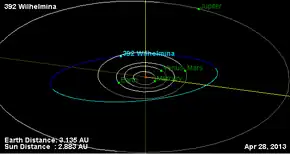 Orbital diagram | |
| Discovery | |
|---|---|
| Discovered by | Max Wolf |
| Discovery date | 4 November 1894 |
| Designations | |
| (392) Wilhelmina | |
| Pronunciation | /ˌwɪlhɛlˈmiːnə, wɪləˈmiːnə/[1] |
Named after | Queen Wilhelmina |
| 1894 BF | |
| Main belt | |
| Orbital characteristics[2] | |
| Epoch 31 July 2016 (JD 2457600.5) | |
| Uncertainty parameter 0 | |
| Observation arc | 121.38 yr (44333 d) |
| Aphelion | 3.29116 AU (492.351 Gm) |
| Perihelion | 2.4759 AU (370.39 Gm) |
| 2.88354 AU (431.371 Gm) | |
| Eccentricity | 0.14136 |
| 4.90 yr (1788.5 d) | |
| 322.000° | |
| 0° 12m 4.633s / day | |
| Inclination | 14.321° |
| 209.819° | |
| 174.112° | |
| Physical characteristics | |
| Dimensions | 62.88±1.5 km |
| 17.96 h (0.748 d) | |
| 0.0589±0.003 | |
| 9.8 | |
Wilhelmina (minor planet designation: 392 Wilhelmina) is a large Main belt asteroid.
It was discovered by Max Wolf on 4 November 1894 in Heidelberg, Germany.
References
- ↑ "Wilhelmina". Oxford English Dictionary (Online ed.). Oxford University Press. (Subscription or participating institution membership required.)
- ↑ "392 Wilhelmina (1894 BF)". JPL Small-Body Database. NASA/Jet Propulsion Laboratory. Retrieved 10 May 2016.
External links
- 392 Wilhelmina at AstDyS-2, Asteroids—Dynamic Site
- 392 Wilhelmina at the JPL Small-Body Database
This article is issued from Wikipedia. The text is licensed under Creative Commons - Attribution - Sharealike. Additional terms may apply for the media files.